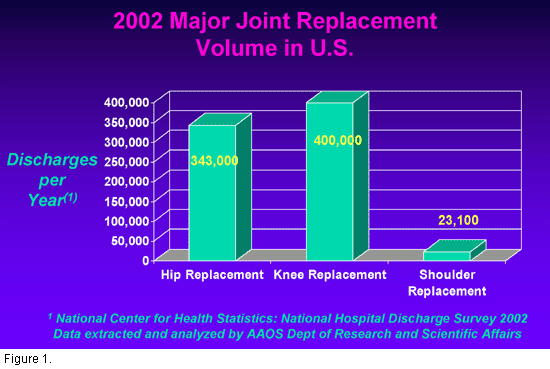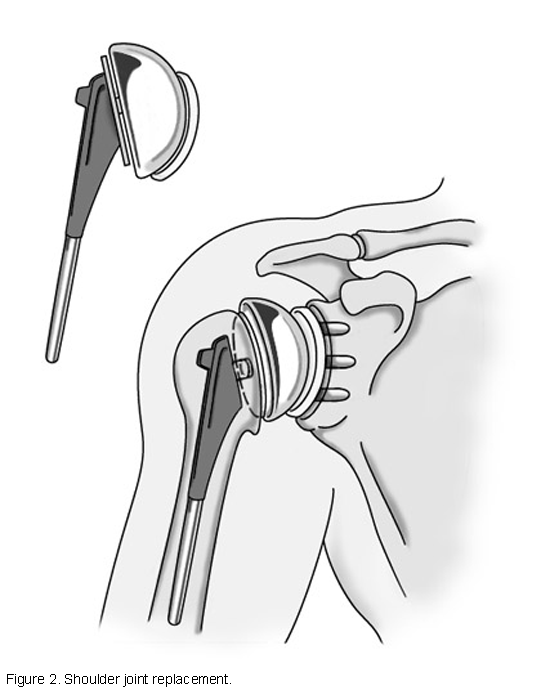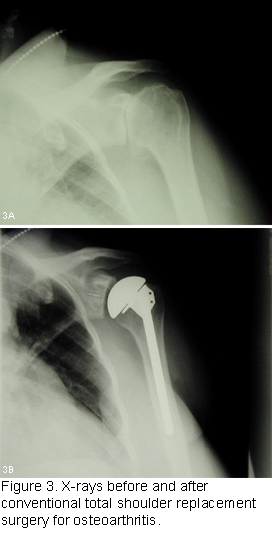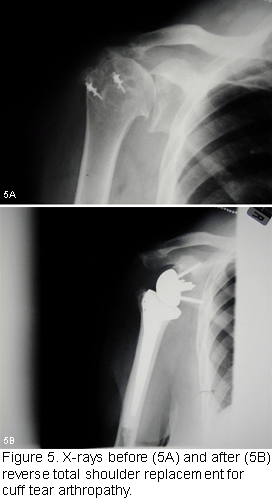Shoulder Joint Replacement
These articles are for general information only and are not medical advice. Full Disclaimer. All articles are compliments of the AAOS
Description
Many people know someone with an artificial knee or hip joint. Shoulder replacement is less common. But it is just as successful in relieving joint pain. Shoulder replacement surgery started in the United States in the 1950s. It was used as a treatment for severe shoulder fractures. Over the years, this surgery has come to be used for many other painful conditions of the shoulder. These include:
- Osteoarthritis (degenerative joint disease)
- Rheumatoid arthritis
- Post-traumatic arthritis
- Rotator cuff tear arthropathy (a combination of severe arthritis and a massive non-reparable rotator cuff tendon tear)
- Avascular necrosis (osteonecrosis)
- Failed previous shoulder replacement surgery
- Severe fractures
Today, many surgeons use shoulder replacement surgery. About 23,000 people have the surgery each year. This compares to more than 700,000 Americans a year who have knee and hip replacement surgery (see Figure 1).

The shoulder is a ball-and-socket joint that enables you to raise, twist and bend your arm. It also lets you move your arm forward, to the side, and behind you. In a normal shoulder, the rounded end of the upper arm bone (head of the humerus) glides against the small dish-like socket (glenoid) in the shoulder blade (scapula). These joint surfaces are normally covered with smooth cartilage. They allow the shoulder to rotate through a greater range of motion than any other joint in the body.
The surrounding muscles and tendons provide stability and support. Unfortunately, conditions like those listed above can lead to loss of the cartilage and mechanical deterioration of the shoulder joint. The result can be a pain. You can have a stiff shoulder that grinds or clunks. This can lead to a loss of strength, decreased range of motion in the shoulder, and impaired function. X-rays of the shoulder would show:
- Loss of the normal cartilage joint space
- Flattening or irregularity in the shape of the bone
- Bone spurs
- Loose pieces of bone and cartilage floating inside the joint
In severe cases, bone-on-bone arthritis may lead to erosion—wearing away of the bone.
Risk Factors and Prevention
Osteoarthritis is a common reason people have shoulder replacement surgery. Osteoarthritis is sometimes called “wear-and-tear” arthritis. It affects mainly older individuals from all walks of life. Over time, the shoulder joint slowly becomes stiff and painful. Unfortunately, there is no way to prevent the development of osteoarthritis.
A severe fracture of the shoulder is another common reason people have shoulder replacements. When the shoulder is injured by a hard fall or car accident, it may be very difficult for a doctor to put the pieces back together. When the head of the upper arm bone is shattered, the blood supply to the bone pieces is interrupted. In this case, a surgeon may recommend a shoulder replacement. Older patients with osteoporosis are most at risk for a severe shoulder fracture.
Patients with a massive long-standing rotator cuff tear may develop cuff tear arthropathy. In this injury, the changes in the shoulder joint due to the rotator cuff tear may lead to arthritis and the destruction of the joint cartilage.
Avascular necrosis is a condition in which the bone of the humeral head dies due to a lack of blood supply. Chronic steroid use, deep sea diving, severe fracture of the shoulder, sickle cell disease, and heavy alcohol use are risk factors for avascular necrosis.
Symptoms
Patients with arthritis typically describe a deep ache within the shoulder joint. Initially, the pain feels worse with movement and activity and eases with rest. As arthritis progresses, the pain may occur even when you rest. By the time a patient sees a physician for shoulder pain, he or she often has pain at night. This pain may be severe enough to prevent a good night’s sleep. The patient’s shoulder may make grinding or grating noises when moved. Or the shoulder may catch, grab, clunk, or lock up. Over time, the patient may notice a loss of motion and/or weakness in the affected shoulder. Simple daily activities like reaching into a cupboard, dressing, toileting, and washing the opposite armpit may become increasingly difficult.
Treatment Options
Treatment of an arthritic shoulder starts with rest, exercise, and taking arthritis medications. Resting the shoulder and applying moist heat can ease mild pain. After strenuous activity, an ice pack may be more effective at decreasing pain and swelling.
Physical therapy may be helpful when arthritis is in its early stages. It helps maintain joint motion and strengthen the shoulder muscles. Physical therapy is less effective when arthritis has advanced to the point that bone rubs on bone. When this is the case, physical therapy may make the shoulder hurt more.
Arthritis medications, called nonsteroidal anti-inflammatories (NSAIDs), can control arthritis pain. Certain NSAIDs may be purchased over-the-counter, while others require a prescription. Periodic cortisone injections into the shoulder joint can provide temporary pain relief. Excessive cortisone shots can have adverse effects, however.
Treatment Options: Surgical
If nonoperative treatments fail, shoulder replacement surgery may be needed. Shoulder replacements are usually done to relieve pain.
There are several different types of shoulder replacements. The usual total shoulder replacement involves replacing the arthritic joint surfaces with a highly polished metal ball attached to a stem, and a plastic socket (see Figure 2).



If nonoperative treatments fail, shoulder replacement surgery may be needed. Shoulder replacements are usually done to relieve pain.
There are several different types of shoulder replacements. The usual total shoulder replacement involves replacing the arthritic joint surfaces with a highly polished metal ball attached to a stem, and a plastic socket (see Figure 2).
Another type of shoulder replacement is called reverse total shoulder replacement (see Figure 4). This surgery was developed in Europe in the 1980s. It was approved by the Food and Drug Administration (FDA) for use in the United States in 2004. Reverse total shoulder replacement is used for people who have:
- Completely torn rotator cuffs and
- The effects of severe arthritis (cuff tear arthropathy) or
- Had a previous shoulder replacement that failed (see Figure 5)
For these individuals, a conventional total shoulder replacement can still leave them with pain. They may also be unable to lift their arm up past a 90-degree angle. Not being unable to lift one’s arm away from the side can be severely debilitating. In reverse total shoulder replacement, the socket and metal ball are switched. That means a metal ball is attached to the shoulder bone and a plastic socket is attached to the upper arm bone. This allows the patient to use the deltoid muscle instead of the torn rotator cuff to lift the arm. This video shows a patient with rotator cuff arthropathy in both shoulders demonstrating her ability to lift her left arm above the horizontal after left reverse total shoulder replacement.
Shoulder replacement surgery is highly technical. It should be performed by a surgical team with experience in this procedure. Each case is individual. Your surgeon will evaluate your situation carefully before making any decisions. Do not hesitate to ask what type of implant will be used in your situation. Ask why that choice is right for you.
Before surgery, patients see their internist or family practice physician for a preoperative medical evaluation. Cardiac patients should see their cardiologist as well. Two weeks before surgery, you should stop taking the following medications that thin the blood and can lead to excessive bleeding during surgery:
- Nonsteroidal anti-inflammatory medications (aspirin and ibuprofen such as Motrin® and Advil®)
- Most arthritis medications
The surgery is performed on an inpatient basis. Most patients are discharged from the hospital on the second or third day after the operation.
Rehabilitation
A careful, well-planned rehabilitation program is critical to the success of a shoulder replacement. You usually start gentle physical therapy on the first day after the operation. You wear an arm sling during the day for the first several weeks after surgery. You wear the sling at night for 4 to 6 weeks. Most patients are able to perform simple activities such as eating, dressing, and grooming within 2 weeks after surgery. Driving a car is not allowed for 6 weeks after surgery.
Here are some “do’s and don’ts” for when you return home:
- Don’t use the arm to push yourself up in bed or from a chair because this requires forceful contraction of muscles.
- Do follow the program of home exercises prescribed for you. You may need to do the exercises 4 to 5 times a day for a month or more.
- Don’t overdo it! If your shoulder pain was severe before the surgery, the experience of pain-free motion may lull you into thinking that you can do more than is prescribed. Early overuse of the shoulder may result in severe limitations in motion.
- Don’t lift anything heavier than a glass of water for the first 6 weeks after surgery.
- Do ask for assistance. Your physician may be able to recommend an agency or facility if you do not have home support.
- Don’t participate in contact sports or do any repetitive heavy lifting after your shoulder replacement.
- Do avoid placing your arm in any extreme position, such as straight out to the side or behind your body for the first 6 weeks after surgery.
Many thousands of patients have experienced an improved quality of life after shoulder joint replacement surgery. They experience less pain, improved motion and strength, and better function.
